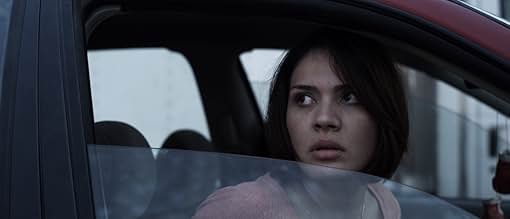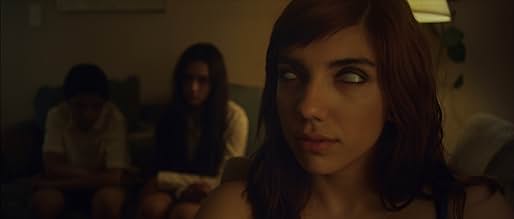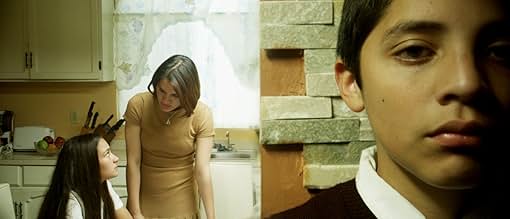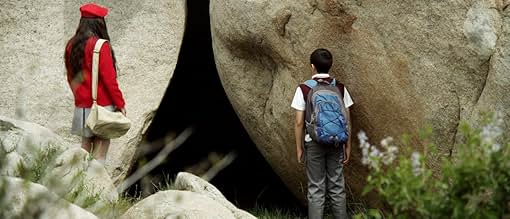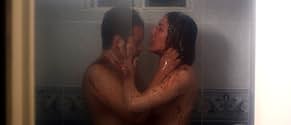ÉVALUATION IMDb
5,6/10
4,6 k
MA NOTE
Ajouter une intrigue dans votre langueA couple loses their children near some caves in Tijuana. The children return to their parents the next day, unharmed. However, something has happened to them.A couple loses their children near some caves in Tijuana. The children return to their parents the next day, unharmed. However, something has happened to them.A couple loses their children near some caves in Tijuana. The children return to their parents the next day, unharmed. However, something has happened to them.
- Director
- Writer
- Stars
- Prix
- 6 victoires et 3 nominations au total
David Arturo Cabezud
- Lucio
- (as David Cabezud)
Enrique Saint-Martin
- Encargado
- (as Enrique Saint Martin)
Julio Granados
- Guardia
- (as Julio Cesar Granados)
Avis en vedette
On the way home to Tiajuana, Mom and Dad stop at a rest stop and their two children want to do some exploring in the nearby caves. (No one seems to consider that there are rattlesnakes and mountain lions in this part of Mexico). The children don't come back, and the parents call the police. The police find the children the next morning and return them to the parents. When the children come home, it slowly becomes obvious that something happened to them in the cave.
This movie is about dread, sex and possession, and it takes the audience down a few blind alleys before it gets to the payoff. However, when it does pay off, it is the stuff of nightmares. Creeping sense of "ick" gives way to horror in the last ten minutes.
Finally, most kids love horror movies, especially if there are kids in them. This is NOT a movie for kids.
This movie is about dread, sex and possession, and it takes the audience down a few blind alleys before it gets to the payoff. However, when it does pay off, it is the stuff of nightmares. Creeping sense of "ick" gives way to horror in the last ten minutes.
Finally, most kids love horror movies, especially if there are kids in them. This is NOT a movie for kids.
A married couple lose their children while on a family trip near some caves in Tijuana. The kids eventually reappear without explanation, but it becomes clear that they are not who they used to be, that something terrifying has changed them.
This is the tenth film from Spanish director Adrián García Bogliano, but likely the first one that will be widely seen by Americans (thanks to it streaming on Netflix). The only other bit we have seen of his work thus far is in the "ABCs of Death" (he had B). And yet, Bogliano is only 33, so a great many things are ahead of him -- onward and upward! Lest you thought this was going to be a fun, kid-friendly film, the opening shot is a fairly explicit lesbian sex scene. And while it never quite hits that mark again, it sets a tone that is easily maintained throughout. If this is not something you care to see, turn it off now.
When watching, keep in mind that Bogliano is influenced by 1970s and 80s exploitation and sleaze, something that ought to lend itself to excellent visuals, not unlike Ti West's embrace of the same era. He specifically has called attention to Nicolas Roeg's "Don't Look Now", a horror classic and a great film in its own right. Does Bogliano live up to his Roeg influence? Perhaps. It would not be fair to say he has become the master, but he is nothing if not an excellent pupil.
My colleague Richard Ostrom has called the film "delectably demented", as well as "moody and unapologetically graphic". Not only is he the master of the apt adjective, but he's also spot on. The film is saturated with a sexuality that dangerously walks the line between erotic and pornographic, both in its imagery and its sensuality. There is plenty of blood, too, but this actually gets overshadowed by the sex -- something not completely foreign to horror, but on a whole new level here.
Jen Chaney, writing on Roger Ebert's website, gives the opposing view, offering the film only one star. She writes that Bogliano lacks sophistication and deems the movie "a 98-minute mess with misogynistic undertones", pointing out the film's questionable obsession with female sexuality. She raises a good point, and an interesting one, but her low rating is overall unfair. With the endless parade of rubbish that passes for horror, this is more than a one star film. Love it or hate it, it is the type of film that gets people talking.
This is the tenth film from Spanish director Adrián García Bogliano, but likely the first one that will be widely seen by Americans (thanks to it streaming on Netflix). The only other bit we have seen of his work thus far is in the "ABCs of Death" (he had B). And yet, Bogliano is only 33, so a great many things are ahead of him -- onward and upward! Lest you thought this was going to be a fun, kid-friendly film, the opening shot is a fairly explicit lesbian sex scene. And while it never quite hits that mark again, it sets a tone that is easily maintained throughout. If this is not something you care to see, turn it off now.
When watching, keep in mind that Bogliano is influenced by 1970s and 80s exploitation and sleaze, something that ought to lend itself to excellent visuals, not unlike Ti West's embrace of the same era. He specifically has called attention to Nicolas Roeg's "Don't Look Now", a horror classic and a great film in its own right. Does Bogliano live up to his Roeg influence? Perhaps. It would not be fair to say he has become the master, but he is nothing if not an excellent pupil.
My colleague Richard Ostrom has called the film "delectably demented", as well as "moody and unapologetically graphic". Not only is he the master of the apt adjective, but he's also spot on. The film is saturated with a sexuality that dangerously walks the line between erotic and pornographic, both in its imagery and its sensuality. There is plenty of blood, too, but this actually gets overshadowed by the sex -- something not completely foreign to horror, but on a whole new level here.
Jen Chaney, writing on Roger Ebert's website, gives the opposing view, offering the film only one star. She writes that Bogliano lacks sophistication and deems the movie "a 98-minute mess with misogynistic undertones", pointing out the film's questionable obsession with female sexuality. She raises a good point, and an interesting one, but her low rating is overall unfair. With the endless parade of rubbish that passes for horror, this is more than a one star film. Love it or hate it, it is the type of film that gets people talking.
Perhaps we are seeing a revolution in Mexican horror cinema today. Along with Jorge Michel Grau's excellent WE ARE WHAT WE ARE (2010), a story about a family of inner city cannibals, who must also like the Mexican horror film industry face change or disappear. Argentian horror film maker Adrían García Bogliano's newest film follows in a lot similar constructs.
Neither of these two recent Mexican horror films follow the country's classic monster horror formula of the past. They are both stylistically and visually very modern horror films. There are also extremely low budget and make excellent use of Mexico's dark and dirty urban settings and focus on the strife of Mexico's lower class families.
After a jarring opening of sex and blood, HERE COMES THE DEVIL is a unnerving, taunt and tension filled tale about a family that starts coming apart after a family trip to the outskirts of Tijuana. Parked at a highway truck stop, the two kids, Sara (Michele Garcia) and Adolfo (Alan Martinez), decide they want to explore a nearby rocky hill while their parent Felix (Francisco Barreiro from We Are What We Are) and Sol (Laura Caro) "relax" in their car, waiting for their two children to return. Soon the frantic parents wake up in the car to realize their children have vanished.
The real star of this film is the direction of Bogliano. From the very opening of this film he creates an atmosphere of tight slow unwinding tension that builds to the perfect closing shot that like the master Mario Bava is a very subversive wink at the audience. Getting to the final shot is where all the fun lies. This film is classic horror film making at it's finest. With excellent storytelling and a very controlled atmosphere, Adrian draws the audience in from the opening and sustains the suspense without giving the audience a chance to catch their breath till the final reveal. The score and sound construction is muted excellence too, that Hollywood horror films sure could learn a thing or too from. Adrian never tries to scare his audience with loud sound effects. Instead he builds brooding momentum with an acoustic guitar melody layered with creepy distant background noises. In one scene he makes fantastic use of a heavy metal song playing on the car radio. As the score builds so does the editing and pacing. This film is an excellent lesson in making the best use of what you have. With minimal characters and a tight focus on a interesting plot, you don't need a lot of money to make a great dark fantasy film. That is not to say that this film didn't have a couple of eye-popping set pieces that had an afternoon TIFF audience hooting and hollering at it's world premier! This film has so many classic horror film references from Hitchcock to Fulci, but what makes this film work is the economy in which it was made.
When it comes down to it this is a smart fun horror film that recalls those classic European grindhouse films that were cheaply made in the 70's & 80's without much fanfare. Fantastic film and my pick for Horror film of the year. Dark Sky should be rewarded for producing this Spanish language film and Argentinian director Bogliano is definitely a name to watch. I know i am now looking forward to going through his back catalog of horror films he made in Argentina looking for some more gems.
Neither of these two recent Mexican horror films follow the country's classic monster horror formula of the past. They are both stylistically and visually very modern horror films. There are also extremely low budget and make excellent use of Mexico's dark and dirty urban settings and focus on the strife of Mexico's lower class families.
After a jarring opening of sex and blood, HERE COMES THE DEVIL is a unnerving, taunt and tension filled tale about a family that starts coming apart after a family trip to the outskirts of Tijuana. Parked at a highway truck stop, the two kids, Sara (Michele Garcia) and Adolfo (Alan Martinez), decide they want to explore a nearby rocky hill while their parent Felix (Francisco Barreiro from We Are What We Are) and Sol (Laura Caro) "relax" in their car, waiting for their two children to return. Soon the frantic parents wake up in the car to realize their children have vanished.
The real star of this film is the direction of Bogliano. From the very opening of this film he creates an atmosphere of tight slow unwinding tension that builds to the perfect closing shot that like the master Mario Bava is a very subversive wink at the audience. Getting to the final shot is where all the fun lies. This film is classic horror film making at it's finest. With excellent storytelling and a very controlled atmosphere, Adrian draws the audience in from the opening and sustains the suspense without giving the audience a chance to catch their breath till the final reveal. The score and sound construction is muted excellence too, that Hollywood horror films sure could learn a thing or too from. Adrian never tries to scare his audience with loud sound effects. Instead he builds brooding momentum with an acoustic guitar melody layered with creepy distant background noises. In one scene he makes fantastic use of a heavy metal song playing on the car radio. As the score builds so does the editing and pacing. This film is an excellent lesson in making the best use of what you have. With minimal characters and a tight focus on a interesting plot, you don't need a lot of money to make a great dark fantasy film. That is not to say that this film didn't have a couple of eye-popping set pieces that had an afternoon TIFF audience hooting and hollering at it's world premier! This film has so many classic horror film references from Hitchcock to Fulci, but what makes this film work is the economy in which it was made.
When it comes down to it this is a smart fun horror film that recalls those classic European grindhouse films that were cheaply made in the 70's & 80's without much fanfare. Fantastic film and my pick for Horror film of the year. Dark Sky should be rewarded for producing this Spanish language film and Argentinian director Bogliano is definitely a name to watch. I know i am now looking forward to going through his back catalog of horror films he made in Argentina looking for some more gems.
This is a fairly straightforward story that lacks surprises but is reasonably entertaining. See it for the shock value. Even by horror standards, this is not for the easily offended; themes include: satanism and the occult, menstruation, gratuitous nudity, gory violence, graphic sex, implied pedophilia, and described incest. Probably not a good movie for a first date!
The story isn't complicated; it meets the expectations set by the title and synopsis. The characters are equally simplistic, their actions implausible, often leading nowhere. The most sympathetic character is the babysitter, who got more than she was bargaining for and doesn't know what the hell happened! (And has the boobs to prove it!)
And what's up with the frequent, jarring camera zooms? The cinematographer should be shot. It's like a technique Robert Rodriguez would use when spoofing '70's grindhouse flicks.
This is the kind of movie you find late night on cable TV. Lots of visual punch to grab the viewer's attention, nothing complicated to force you to think too much, impulsive action that shows the writers weren't having to think too much either. Enjoy it for the gonzo exploitation flick it is and don't expect anything more.
The story isn't complicated; it meets the expectations set by the title and synopsis. The characters are equally simplistic, their actions implausible, often leading nowhere. The most sympathetic character is the babysitter, who got more than she was bargaining for and doesn't know what the hell happened! (And has the boobs to prove it!)
And what's up with the frequent, jarring camera zooms? The cinematographer should be shot. It's like a technique Robert Rodriguez would use when spoofing '70's grindhouse flicks.
This is the kind of movie you find late night on cable TV. Lots of visual punch to grab the viewer's attention, nothing complicated to force you to think too much, impulsive action that shows the writers weren't having to think too much either. Enjoy it for the gonzo exploitation flick it is and don't expect anything more.
"Here Comes the Devil" by Adrián García Bogliano is a captivating exploration of parental love, supernatural dread, and the fragility of family unity. Set against the sun-drenched yet ominous backdrop of Tijuana, the film begins with the disappearance of two children during a family outing. When they return the next morning, something feels disturbingly different, sparking their parents' investigation into an initial suspicion of abuse-only to uncover something far darker at play.
What sets this film apart is its daring blend of styles and themes. Rooted in the eerie atmospheres of 1970s horror cinema, "Here Comes the Devil" evokes the classics with its grainy visuals, rapid zooms, and low-budget charm. These stylistic choices, while seemingly amateurish at times, contribute to the film's unsettling rhythm, keeping viewers engaged as the story unravels.
Bogliano crafts a layered narrative that juxtaposes familial devotion with themes of possession, loss of innocence, and diabolical influence. The supernatural presence-though never explicitly shown-looms large, manifesting through the children's chilling behavior and the fracturing of their parents' relationship. This subtle approach heightens the tension, proving that psychological and emotional terror can be far more effective than overt scares.
The film's opening scene-a shocking mix of explicit sexuality and brutal violence-sets the tone for a story that refuses to shy away from provocative territory. As the narrative progresses, the mother's increasing belief in a malevolent force contrasts sharply with the father's rational skepticism, creating a compelling dynamic that anchors the escalating horror in relatable human conflict.
The final act shifts focus to familiar horror tropes, including possessed children and supernatural forces, yet it handles them with a fresh sense of dread and ambiguity. The closing moments, deliberately unresolved, leave viewers pondering the pervasive nature of evil and the enduring vulnerability of the human spirit.
It succeeds as an effective horror film that prioritizes atmosphere and emotional resonance over cheap thrills. It is a haunting meditation on parental fear, the loss of innocence, and the darkness that lies just beneath the surface of normalcy.
Although the devil is never explicitly seen, his presence is felt through the actions of the children and the breakdown of the family. The title "Here Comes the Devil" suggests that evil is always present, ready to corrupt.
What sets this film apart is its daring blend of styles and themes. Rooted in the eerie atmospheres of 1970s horror cinema, "Here Comes the Devil" evokes the classics with its grainy visuals, rapid zooms, and low-budget charm. These stylistic choices, while seemingly amateurish at times, contribute to the film's unsettling rhythm, keeping viewers engaged as the story unravels.
Bogliano crafts a layered narrative that juxtaposes familial devotion with themes of possession, loss of innocence, and diabolical influence. The supernatural presence-though never explicitly shown-looms large, manifesting through the children's chilling behavior and the fracturing of their parents' relationship. This subtle approach heightens the tension, proving that psychological and emotional terror can be far more effective than overt scares.
The film's opening scene-a shocking mix of explicit sexuality and brutal violence-sets the tone for a story that refuses to shy away from provocative territory. As the narrative progresses, the mother's increasing belief in a malevolent force contrasts sharply with the father's rational skepticism, creating a compelling dynamic that anchors the escalating horror in relatable human conflict.
The final act shifts focus to familiar horror tropes, including possessed children and supernatural forces, yet it handles them with a fresh sense of dread and ambiguity. The closing moments, deliberately unresolved, leave viewers pondering the pervasive nature of evil and the enduring vulnerability of the human spirit.
It succeeds as an effective horror film that prioritizes atmosphere and emotional resonance over cheap thrills. It is a haunting meditation on parental fear, the loss of innocence, and the darkness that lies just beneath the surface of normalcy.
Although the devil is never explicitly seen, his presence is felt through the actions of the children and the breakdown of the family. The title "Here Comes the Devil" suggests that evil is always present, ready to corrupt.
Le saviez-vous
- AnecdotesThe credits include a page of Spiritual Help ("Ayuda Espiritual") which lists: Nicolas Roeg, Henry James, Neither the Sea Nor the Sand (1972), director Sergio Martino, Spanish director Eloy de la Iglesia, The Centerfold Girls (1974), David Cronenberg, Donald Cammell, Pique-nique à Hanging Rock (1975), L'emprise (1982), singing group Los Iniciados, horror writer T.E.D. Klein, writer/director Sebastián De Caro, Le souffle du démon (1992), William Finley, Marilyn Burns and classic rock station KGB San Diego.
- ConnexionsFeatures Le crocodile de la mort (1976)
- Bandes originalesAOK in the USA
Performed by Knife of Simpson (as Knife Of Simpson)
Under license from Nathan E. Perry
Meilleurs choix
Connectez-vous pour évaluer et surveiller les recommandations personnalisées
- How long is Here Comes the Devil?Propulsé par Alexa
Détails
- Date de sortie
- Pays d’origine
- Sites officiels
- Langue
- Aussi connu sous le nom de
- Here Comes the Devil
- Lieux de tournage
- sociétés de production
- Consultez plus de crédits d'entreprise sur IMDbPro
Box-office
- Brut – États-Unis et Canada
- 4 534 $ US
- Fin de semaine d'ouverture – États-Unis et Canada
- 783 $ US
- 15 déc. 2013
- Brut – à l'échelle mondiale
- 4 534 $ US
Contribuer à cette page
Suggérer une modification ou ajouter du contenu manquant

Lacune principale
By what name was Ahí va el diablo (2012) officially released in India in English?
Répondre



